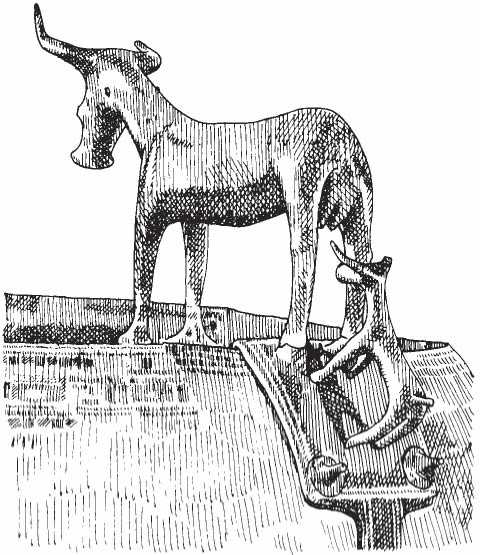'The greater part of their food consists of milk, cheese and meat': so commented Julius Caesar about the Celt-related Germanic tribes he encountered during his conquest of Gaul in the mid-first century BC.138 Strabo remarks that the British Celts used milk but did not make
Cheese.139
Milk could be obtained from cattle, sheep or goats. Sheep give a poor milk yield relative to that from goats, but goats are less easy to keep in a temperate climate and, since sheep were kept anyway for their wool, it is likely that they were milked as well.140 We know of an Insular Celtic festival, Imbolc, on the 1st of February, which celebrated the early spring lactation of ewes.141 The high neonatal mortality rate for lambs evidenced at Danebury meant that the milk of the corralled and bereft ewes was available for human consumption.142
Most milk was probably taken from cattle. The Dexter cattle raised at Butser were found to give an adequate milk supply even when fed on relatively poor pasture.143 But certain factors need to be taken into account when cattle are reared for milk, especially during the Iron Age. Firstly, a milch-cow requires a great deal of water. Secondly, Celtic cows were smaller than modern species and gave milk for only a short time after calving.144 If milk was required as a regular and important source of food, the management of cows and calving would have been a major preoccupation of the pastoral farmers. Cows mature at about two and a half years old; they will then calve virtually every year for five or six years after that. A cow gives her maximum yield when she is between 7 and 10 years old.145
Peter Reynolds observed that his Dexter cattle lactate for around ten months. If humans wished to take advantage of cows' milk, then either the calves could be weaned early (stoppers could be placed in the udder to prevent the calf from suckling, or cow and calf could be separated), or they could have been culled for meat: culling occurred at certain Gaulish

Figure 2.21 Handle of bronze vessel, in the form of a cow and calf, sixth century BC, from the Hallstatt cemetery, Hallstatt, Austria. Length of cow: 14.4cm. Paul Jenkins.
Settlements, such as Villeneuve-Saint-Germain.146 Certainly during the Iron Age and Romano-Celtic periods, there was some dependency upon cows' milk: for the community at Danebury, it was a source of protein along with meat. In the Roman period, the people living at Portchester in Sussex kept cattle that were mainly female, and the supposition is that they were exploited for milk.147
Milk is an important food, especially in temperate Europe. This is because it is a rich source of vitamin D, the other main source of which - sunlight - may be conspicuously scarce in this region. North Europeans, unlike some other peoples of the Old World (notably West Africans, Chinese and the peoples of Southeast Asia), are able to digest milk-sugar (lactose) because they possess the enzyme lactase. Iron Age Celts were therefore probably able to use milk in its liquid, unconverted form. They may, also, have made yoghurt and, despite Strabo's comment about the Britons, it is almost certain that they produced cheese. In his Natural History, Pliny148 alludes to cheesemaking among the Gauls, and observes that the Romans ate cheese imported from the provinces, particularly from the area of Nimes. He especially mentions goat's cheese. Both wicker baskets and leather containers could have been used in the cheese-straining process.149 Butter may also have been made, and used in cooking and flavouring. Both cheese and butter were presumably discovered in antiquity by accident: by chance observation of curdling milk in the case of cheese, and by the agitation of milk in the case of butter.
Eggs
The evidence for chickens, ducks and geese on Iron Age habitation sites and in graves suggests that these birds were kept for their eggs. They would have been a significant source of protein and a welcome variation in the diet of Celtic communities. Eggs were actually found as part of the grave-goods buried with the Celtic warrior chieftain and his chariot at La Gorge Meillet (Marne).150 Deities depicted in Romano-Celtic iconography carry eggs: the healer-goddess Sirona at Hochscheid in Germany is depicted carrying a bowl containing three eggs; and the Genii Cucullati portrayed at Cirencester (Glos.) bear eggs as fertility symbols.151
Honey
The use of honey as a sweetening agent, for preserving and for fermenting to make mead must have been well known to Iron Age Celts. Beeswax may also have been recognized as useful, perhaps as a sealant for containers. Archaeological evidence is sparse, but there are sufficient indications for us to assume not only the collection of wild honey but also some knowledge of apiculture. Mead is attested, for instance, by the 'mead-vat' found in the grave of the Hochdorf Hallstatt prince, a huge bronze cauldron containing the sediment of 400 litres of mead.152 A number of pottery containers found on Iron Age sites may well have been holders for honey or wax. That beekeeping was practised in Iron Age Britain is evidenced by the discovery of the head of a worker-bee preserved in peat at the bottom of an Iron Age sump at Hardwick (Oxon.). Waterlogged wood from the site has yielded a radiocarbon date of 220±90 BC. The first century AD site of Caldecotte in Buckinghamshire has also revealed evidence of apiculture.153
The early Irish tales speak of honey and the making of mead.154 Honey was used in cooking and there are Insular literary references to meat rubbed with honey and salt and cooked over an open fire. Salmon was also baked in honey. The name of the mythical Queen Medb of Connacht may be associated philologically with mead intoxication. Mead was drunk at the great sacred Celtic festivals, and the official name of the assembly hall at Tara (a royal court over which Medb presided) is Tech Midchuarta, the House of the Mead Circling. Classical writers refer to a honey drink which may or may not have been fermented to produce mead. Diodorus Siculus155 says that the Celts washed honeycombs and used the washings as a drink.




 World History
World History









